Course Project
The course project is your chance to gain hands on HRI research experience. You are expected to complete this project in a group of 2 to 4. This project must involve conducting a human-subjects study that answers a novel research question focused on the interaction between a physically embodied robot and 1 or more people. This page contains details on the project deliverables, due dates, as well as examples of prior projects (at the bottom of the page).
Project Deliverables & Due Dates
Project Timeline
| Due Date | Time Due | Project Deliverable |
|---|---|---|
| Thu, Apr 3 | 2:00pm CST | Pitch 1-3 Project Ideas |
| Mon, Apr 7 | 8:00pm CST | Draft Project Proposal |
| Tue-Mon, Apr 8-14 | Refine Project Proposal | |
| Mon, Apr 14 | 1:30pm CST | Finalized Project Proposal |
| Wed, Apr 30 | 1:30pm CST | Progress Report #1 (everyone) Literature Review (for students taking 30630) |
| Wed, May 14 | 1:30pm CST | Progress Report #2 |
| Wed, May 28 (Finals Period) | 12:30pm - 2:30pm | Project Presentations to Class |
| Thu, May 29 | 5:00pm CST | Project Final Report, Teaming Survey, and Data Sharing |
Submission of Project Deliverables
Put your project pitches in this Google doc. All other project deliverables will be submitted on Canvas.
Project Pitches
Before pitching project ideas, read this entire web page thoroughly to get the full picture of what this project will entail.
Although the project will be completed in teams of 2-4, these pitches are made by individuals. The purpose of these project pitches is to aid in the formation of project teams (your project proposal can and will deviate from these project pitches, again, the project pitches are meant to serve as a starting point for team formation). In this Google document you’ll pitch 1-3 project ideas that you’d be interested in pursuing for the course project. It does not need to be fully formed, but enough to give your classmates a good idea of what the project will entail.
Draft Project Proposal
The draft proposal should be 1-2 pages in length and describe:
- The research question(s) you are investigating and any related hypotheses
- The methods you expect to use to answer your research question (e.g., experimental conditions, experiment protocol, questionnaire measures, measurements of human behavior)
- How you plan to evaluate whether or not you've answered your research question (e.g., statistical analysis, thematic analysis, comparison against a state-of-the-art approach)
Finalized Project Proposal
The finalized project proposal, in addition to what is contained in the draft proposal, should detail a detailed timeline with corresponding intermediate deliverables. Before submitting your final project proposal, please set up a meeting with a member of the teaching team in the range of Wed-Fri, April 9-11. You'll receive an email from me on how to sign up for a time to meet with us to discuss your project proposal.
Progress Reports
The progress report should contain:
- An update on your progress relative to your project proposal timeline (1 paragraph)
- The accomplishments you've made since the last project deliverable (1 paragraph or a bullet point list)
- Any unexpected roadblocks you've encountered (1-2 paragraphs or a bullet point list)
- An updated timeline of how you plan to complete the project
Literature Review (For Students Taking 30630)
If you are taking the grad level of the course (30630), you will write and submit a literature review of prior work that is relevant to your project. If there are multiple students on your project team taking 30630, each of you must write and submit an independent literature review. This literature review should resemble the background sections of the papers we read in class. Your literature review should:
- Contain at least 15 references to prior related work,
- Summarize the prior work as it relates to the context of your project, and
- Highlight the gaps in prior work (that your work will then fill).
The literature review should be written in the style of an academic conference paper (like the papers we've been reading for our class discussions), feel free to use the ACM templates for conferences.
Project Presentation
You will present the work that you've done in your course project during finals period. You should aim for your presentation to take 10-12 minutes, leaving 3-5 minutes for Q&A and transitioning to the next group (I will plan to cut you off if your presentation goes beyond 12 minutes). All members of your team are expected to participate in the presentation. Your slides should be uploaded to Canvas by the start of the class meeting where you will present. Your presentation should highlight the following:
- Motivation: Detail the research question(s) you were interested in investigating and why it's important to explore.
- Background: Describe any relevant background literature and tell us what unique and novel contributions your study is making beyond what already exists in the literature.
- Methods: Describe your study design (experimental conditions), hypotheses, study protocol (videos are great for this), and the measures you used to assess your hypotheses.
- Video: Show video clip(s) giving example(s) of the interactions participants had with the robot in each of your experimental conditions.
- Results: Report on the results you found. Please include all of the main measures, regardless of whether or not you found significant differences.
- Discussion/Implications: Reflect on the broader implications and takeaways from your results.
- Learning Outcomes: Enumerate some "lessons learned" from this project, what you learned by going out and actually conducting HRI research, beyond what you've learned from reading the papers in this class.
Final Report
The project report should be written in the style of an academic conference paper (like the papers we've been reading for our class discussions), feel free to use the ACM templates for conferences. The report should have the following sections: abstract, introduction, background, methods, results, discussion, conclusion, and contributions. The abstract - conclusion sections should resemble the papers we have read and discussed in this course. The contributions section should detail the contributions of each team member, detailing which portions of the project were completed by each team member. The report should be approximately 6 pages long without references.
Teaming Survey
Due at the same time as your final report, ensure that you've filled out the course project teaming survey. Assuming that all team members make approximately equal contributions on the course project, all team members will receive the same grade. However, if certain team member(s) do not contribute a sufficient amount of work to the course project, each team member may receive a different grade that reflects their individual contributions.
Data Sharing
If you have not done so already, please share all of the data you've collected in your HRI project in a UChicago Box folder and add the teaching team to the shared folder. This includes questionnaire data, video data, and any other data you collected in your project.
Project Grading
The grading for the course project will be as follows:
- 15% intermediary deliverables - project pitches, proposals, progress reports
- 10% final project presentation
- 25% final report
- 50% project work - your grade based on the work that you accomplished during the class project is not dependent on your project being a 'success', your project work will be graded based on the project's scope, novelty, and the investigative work that you put into pursuing your research questions
For further details on project grading, please check out the final project grading rubric.
Helpful Information for Running Your Human-Subjects Study
Suggested Timeline
For running an in-person human subjects study, here's an example timeline of what your project work might look like:
- Weeks 1-3: Form project team, finalize study design (main research questions, experimental conditions, protocol, measures)
- Week 4: Develop study protocol, questionnaires, consent forms, etc. and submit your IRB application
- Week 5: Program the robot and go back-and-forth with the IRB if they request any changes to your IRB application
- Week 6: Pilot the study
- Weeks 7-8: Run human subjects
- Week 9: Conduct data analysis
- Week 10: Work on presentation and final report
Human Subjects Protection Training
Since you will be conducting a human subjects study in your class project, you will need to submit an IRB (Internal Review Board) Application and have completed Human Subjects Protection Training (← that link contains all the info you need to complete the training). Before you submit your IRB application, you must have already completed the human subjects protection training.
UChicago Internal Review Board (IRB) Application
In order to conduct human subjects research in affiliation with UChicago, you must submit and get approved an Internal Review Board (IRB) application. This means that BEFORE you run any human subjects, you MUST have your IRB application approved. For HRI related research, we submit our IRB applications to UChicago's Social and Behavioral Sciences Institutional Review Board (SBS IRB). Their main website, https://sbsirb.uchicago.edu/, contains helpful information, templates, and guidance for completing an IRB application.
The purpose of the IRB is to ensure that UChicago research is being conducted ethically and with proper respect to human participants. Your IRB application will include:
- a high-level description of the research you plan to conduct
- a protocol specifying what each human participant will do in your research study
- a consent form that each participant will read and agree to before beginning your research study
- a description of how you plan to protect any identifiable data you collect from human participants and how you plan to store the data
- any questionnaires you plan to administer to the human participants
- any recruitment methods you plan to use (e.g., flyers, social media posts, emails)
- details on how participants are to be paid and how much they will be paid
To create, edit, submit, and amend your IRB application go to https://aura.uchicago.edu/ and click on the "IRB" button.
It is most helpful to model your IRB application after one that has already been approved. Please ask the teaching staff to provide you with model IRB application examples to help you as you create your own.
When you complete your own IRB, please put me (Sarah) as the PI and all other teaching team members as collaborators on the personnel list. Since I (Sarah) will be the PI for the IRB, this means that I must be the one to hit the "submit" button whenever you submit the IRB application or revisions to your IRB application. Please email me when you are ready to make an IRB submission, and I will hit that "submit" button.
HRI Measurement Scales
HRI researchers at the Naval Research Lab and George Mason University have compiled a database of scales HRI researchers use in their studies. I highly encourage you to visit their website Finding the "Perfect" Scale (especially their database page) where you can find questionnaire scales you can use for your study as well as a rating of the quality of each scale.
Qualtrics
If your study involves asking human participants to fill out a questionnaire, I recommended that you use Qualtrics. In order to get all the nice bells and whistles that comes with Qualtrics, we highly recommend that you request a pro account. You can do this by completing this User Agreement Form (for more context, see this UChicago ITS post about using Qualtrics at UChicago).
Recruitment
You will be responsible for recruiting your own participants. You can post on social media, send emails, post on UChicago organization sites, etc. Just be sure that you include all forms of recruitment in your IRB application that you plan to use. We recommend you try to recruit the following minimum number of participants, dependent on your group size:
- Group of 2: at least 16 participants
- Group of 3: at least 20 participants
- Group of 4: at least 24 participants
Robot
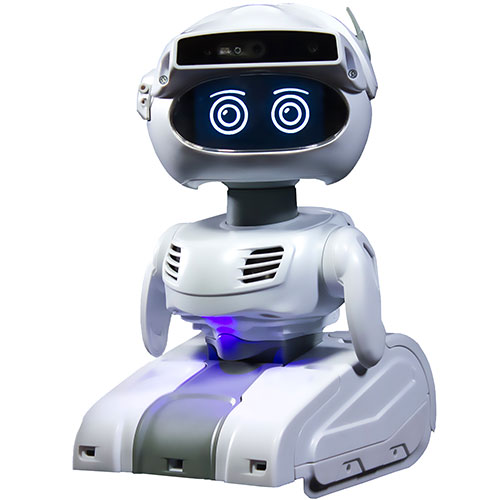
For this class, you will use a Misty II robot for your project. Misty can locomote (using treads), move its arms and head, show different expressions on its face, and talk-back-and-forth with people. We will have 3 labs devoted to gaining experience programming Misty with the Misty Python API.
Payment
For in-person human participants, we will pay them at the rate of $12.00 per hour in the form of Amazon gift cards. To facilitate this payment, please email the teaching team daily when you are running your study with a list of email addresses that correspond with your study participants from that day. I will ensure that they are sent their Amazon gift card for participating in your study.
Piloting Your Study
It is SO important before you start running real human subjects that you practice, practice, practice executing your human subjects study. We recommend:
- Running the study several times yourselves from top to bottom, AND
- Running the study one one or two friends (including having them fill out the questionnaires) and asking them if anything was confusing or if they noticed any typos in your questionnaire, AND
- Running the study on members of the teaching team and getting their feedback.
Examples Projects from Prior Topics in HRI Student Teams
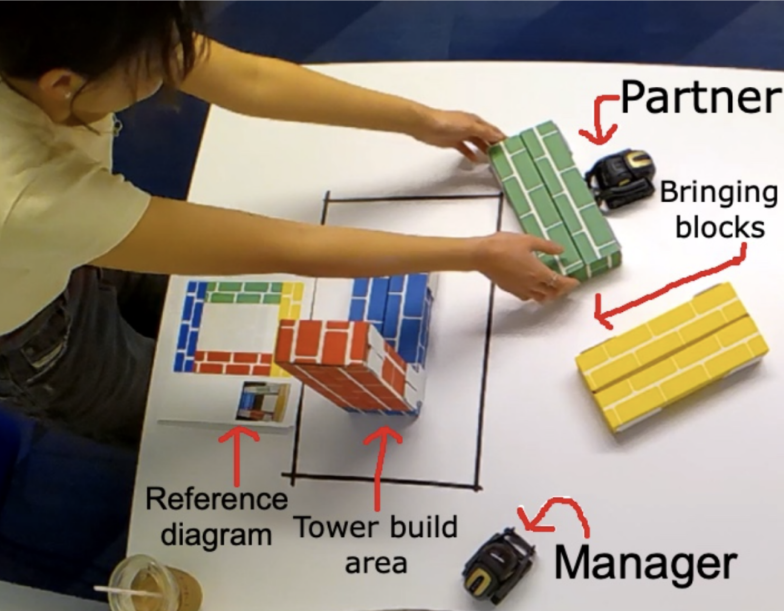
As robots become increasingly capable and widespread, they may be placed into roles of relative authority where they give people instructions (e.g., directing human coworkers in a warehouse). Given people's tendency to comply with either robot or human instructions, it is important to better understand the factors that may influence human compliance to robot instructions, especially if these instructions may undermine another person or robot. In this work, this project team investigated to what extent an established robot-robot relationship would impact a person's choice to comply with instructions from one robot to undermine another robot. They ran a between-subjects study (N = 10) where participants collaborated with one a partner robot to build a series of towers at the direction of a manager robot. These two robots were either presented as an ingroup with a shared history and preferential treatment of one another (ingroup condition) or as an outgroup without shared history and negative treatment of one another (outgroup condition). In response to the manager robot's instructions to the human participant to undermine the partner robot, their results show that participants in the ingroup condition are more likely to abuse the partner robot per the manager robot's commands than in the outgroup condition. The ingroup robots were perceived as more warm, more competent, and causing less discomfort.
The students who worked on this project continued working on this project after the quarter ended, re-vamped the study design, ran 50 new participants, and are working to get the resulting paper submitted to an academic conference or journal.
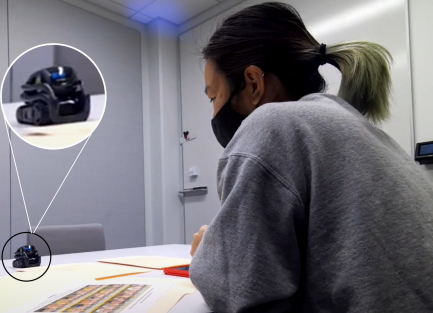
Robots are becoming increasingly prominent in the entertainment sphere, where they interact with guests in themed environments to tell stories, often in place of human characters. To evaluate the potential benefits of robots in these contexts compared to humans, this team created an interactive puzzle game where either a robot or a human actor serves as a diegetic “game guide” character that is both a cooperative partner and an omniscient game master. In the game, participants solve a crime mystery by asking the game guide for information to complete tasks and for hints to solve puzzles. They conducted a between-subjects study (n = 25) to investigate how players’ game experiences differed when the game guide was a human compared to an embodied robot. Their results showed that participants playing with a robot had more fun, felt more comfortable and less awkward, and made more progress in solving the tasks compared to those playing with a human. These results suggest that robots can be effective alternatives to human actors in broader immersive entertainment contexts such as escape rooms to provide greater enjoyment and promote more social interaction with in-game characters.
The students who worked on this project continued working on this project after the quarter ended and published a paper on this project at the 2022 RO-MAN conference.
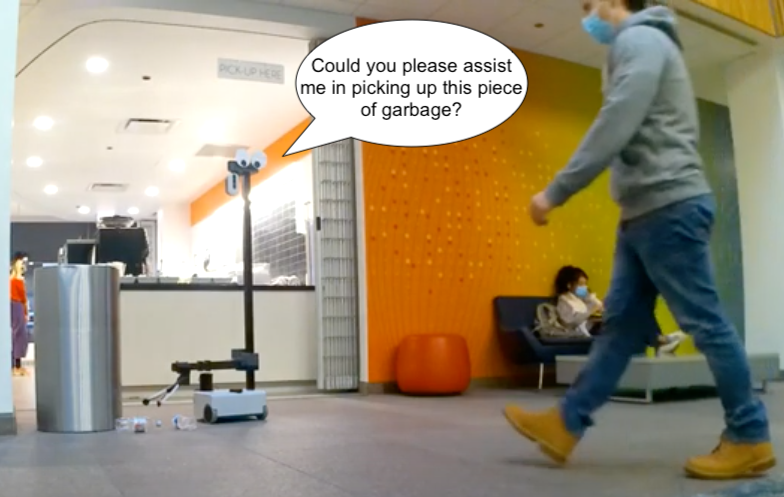
This project explored how the addition of eyes to a non-humanoid robot affects human responses to requests for assistance from the robot. The experiment was executed in a public setting (near Peaches on the first floor of JCL), with the Stretch robot asking passers-by for help picking up an item of garbage. Participants interacted with a robot with and without eyes by assisting it to pick up a piece of trash that it audibly requested help with. Most people from whom the robot requested help paused to assess the situation, however, the team found far more participants in the eye condition actually intervening. The no eyes condition had similar rates of participants pausing to view the robot, but these participants more often described confusion about the source of the voice or the intentions of the robot. The team also recorded whether the people that approached the robots were individuals or small groups. They found that all the small groups that they recorded chose to intervene, they believe, because members of small groups were more likely to stop and discuss the robot, as well as to reassure each other about how to assist it.
You can find a fun YouTube video demonstrating this project at this link.
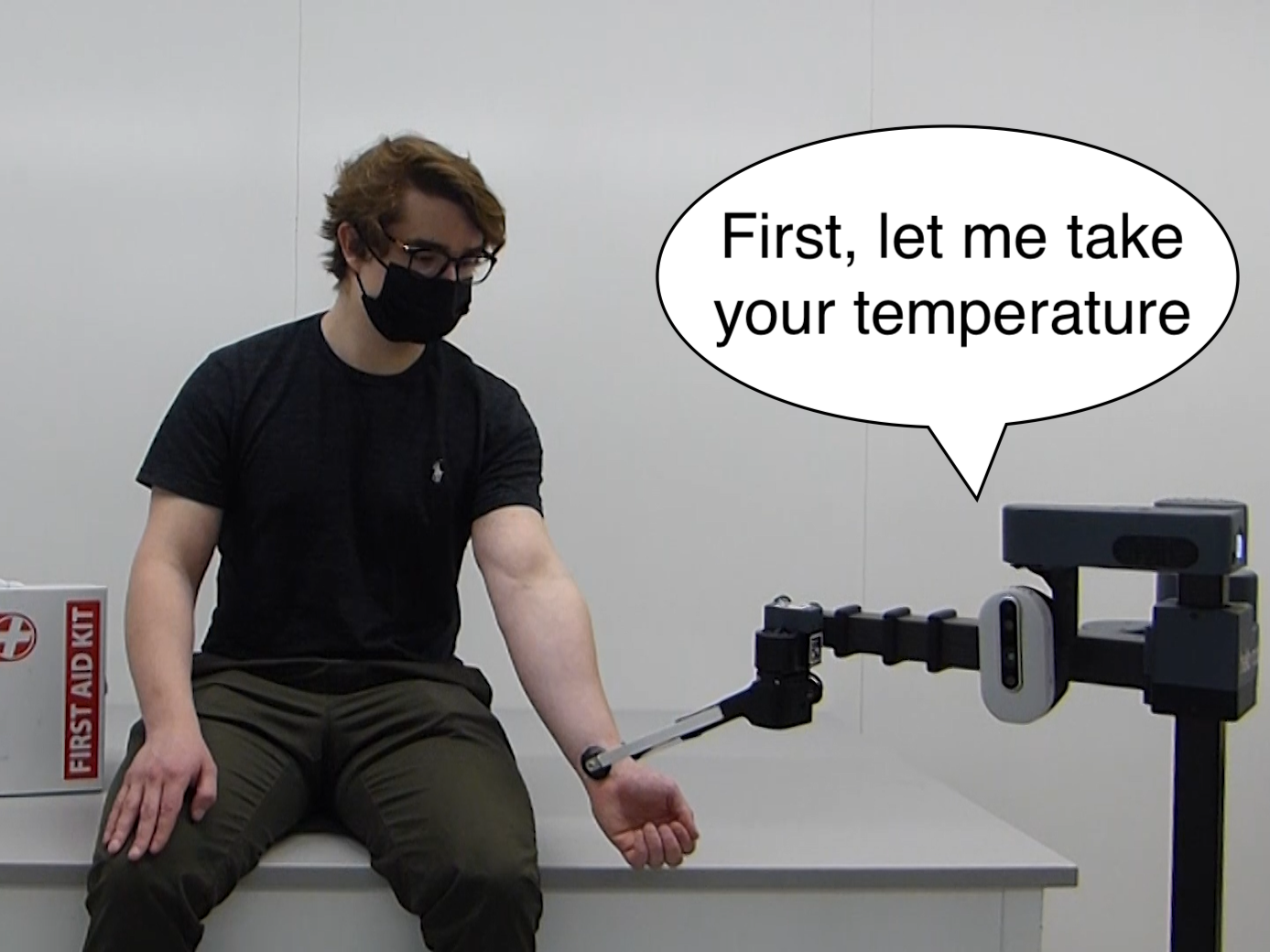
Human-robot touch offers a compelling medium for communication; touch can be used both to perform tasks (instrumental touch) and provide comfort (affective touch). Deliberate, physical contact with humans is especially applicable for healthcare robots because touch is frequently employed and often necessary to provide patients with medical aid and emotional support. To understand the factors that influence how people perceive robotic caregivers, these students conducted a 2x2x2x2 crowd-sourced study on Prolific, where each participant viewed a video recording of one of the students being given a medical exam by a robot and then filled out a Qualtrics survey based on the observed video clip. The students examined how the perceived quality of care is affected by the presence of touch (present or absent), type of touch (instrumental or affective), robot appearance (Nao or Stretch), and robot tone (empathetic or serious). Their findings confirmed that instrumental touch is more important to quality of care than affective touch and were able to suggest several guidelines for designing robot personality and appearance to maximize the warmth, competence, and comfort of a patient’s experience.
The students who worked on this project continued working on this project after the quarter ended and published a paper on this project at the 2022 RO-MAN conference.
Note: This study was conducted on Prolific (a crowd-sourcing platform) because the covid-19 pandemic prevented these students from running any in-person human subjects.